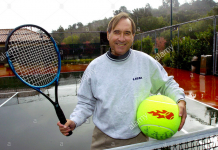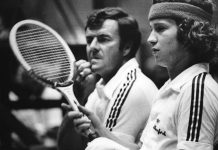A spiraling economy hit the NTRP tournament trail in the gas tank but not hard enough to keep players off the freeway. And player numbers, in fact, grew in spite of it. For the year, the unique (actual) NTRP player count was up 3 percent, according to USTA NorCal. But tournament entries were down by 1 percent and some 5.5 men and 4.5 women players just vanished.
“We had a rough winter and spring and almost though the summer,” said Jason Scalese, the section’s head of adult tournaments. “Players were staying closer to home.”
Just a few Grand Prix players said they limited their tournaments to one-hour distances or started carpooling for the first time. But one player, driving himself to the limits to be the best he could be, wasn’t fazed. Walnut Creek’s Brian McConnell (see NTRP Player of the Year) appeared to set a record by playing 27 tournaments.
2.5
Only the women got a playoff because their turnout at this beginner level was sufficient. Roseville’s Tammy Williams was invited to play on a Johnson Ranch 2.5 team in April. The 40-something mom with five kids ages nine to 19 was bored with her jogging workouts, and ready for just such an invite. Williams said she didn’t know how to hold the racket and found the scoring so complex that she had to carry notes on court. But she then discovered tournaments and dived in. She won all four she played, losing just two sets, before annexing the Grand Prix. “It’s an amazing challenge,” Williams says. “I don’t know the game — I just play instinctively. My matches usually last three hours. My kids were my hobby and I never really considered something for myself, until now.”
3.0
Having been to the GP playoff twice without ever winning a set, Stanley Boehm wasn’t expecting much at the ‘08 Grand Prix. But the 62-year-old ended up beating top-seeded West Motscham in the final 6-4, 2-6, 6-4. Boehm, a 30-year player, is a retired a recreational specialist who worked with Napa State Hospital’s criminally insane population. In ‘08, Boehm won seven of the 25 tournaments he played. In August, he won four in a row. Meanwhile, he played on five league teams. “I had lost to Wes once before, but I had also beaten him three times,” Boehm said. His coach, Meadowood’s Doug King, helped him find weight balance in shotmaking, and it translated into Boehm’s third-time charm. By contrast Dani Toskova Zopp picked up a racket for the first time in April. She entered a 2.5 tournament, won it, and never looked back. She jumped into the 3.0s and played 15 tournaments. She lost every match until a win in mid-June reversed her fate. After that, she won seven of eight tournaments including the Grand Prix. Her coach, John Thomas, couldn’t be prouder. Zopp, who has her own telecommunications equipment supply company in Redwood City, got married on a tennis court in ‘08. Now, she and her player-husband enter tournaments every weekend. “Tennis is a nice thing to complete our lives,” she says.
3.5
Robert Cantu, a former high school baseball pitcher, took up tennis in ‘06, and was soon in for some thrills. The 36-year-old who started his own Santa Rosa construction company in ‘02 was down double-match point in the Grand Prix finals before coming back to upend top-seeded Jesse Apodaca 4-6, 7-5, 6-3. “I was so focused I later lost track of the score in the third set,” he said. Cantu, whose wife also competed at the Grand Prix, played on four league teams and in eight tournaments, winning two. Cantu upset No. 2 seed McConnell in a three-set semi. Novato’s unseeded Saundra Beacham upended top-seeded Rosa Newman 7-6(6), 7-6(4) in the first round or the Grand Prix, then won her semi in three sets before dismissing Karen Verbica 6-2, 6-2 in the final. Going in, Beacham was a darkhorse. Although she had won her first two tournaments of the season, she went on to lose her next six, including the Roseville 3.5 final to Newman just two weeks before their Santa Clara showdown.
4.0
Unseeded and down a set in the Grand Prix final, Jerry Chou of El Dorado Hills still wasn’t blinking against Rudy Abitago. After more than two years of playing in pain, a shoulder tear in Chou’s shoulder had finally gotten spotted by doctors and he underwent surgery. It took him nine months to recover. The Wells Fargo compliance analyst says he grew “exponentially better,” winning the first of four tournaments in May. He played in nine. So, feeling healthy and confident, Chou rolled in the final to the 2-6, 6-4, 6-4 win. It helped that he knew Abitago’s game. They had been teammates in Fremont. Rohnert Park’s Nancy Wong discovered that there’s nothing that helps in a showdown quite like experience. She had plenty in ‘08, playing 35 matches on eight league teams plus 10 tournaments, winning six. But in a loss to Christine Dumery in the semis of the South Bay 4.0 NTRP in late August she learned what to expect. “She [Dumery] hit with a lot of slice and pace at the South Bay,” Wong said. “But at the Grand Prix (playoff) I stayed with her a little better — I was familiar with her game.” She beat Dumery in the final online casino 6-4, 5-7, 6-3. Wong, an accountant, and her husband own The Competitor, a tennis shop in Santa Rosa. The mother of two rediscovered tennis five years ago.
4.5
Sometimes a grudge drives a player. Take Arthur Labrador, a San Jose software consultant who played at Foothill College some years back. Labrador kicked off the season with a three-set loss to Jose Ramirez that got ugly, he says. The two didn’t see eye to eye, and an umpire was called. Labrador sought revenge. Three months later they met again at a Foster City 4.5 tournament. Labrador won 6-0, 6-0. Then, ending the season, the unseeded pair met in the GP final. Labrador prevailed 6-4, 6-1. “It came full circle with him,” Labrador says. And the air between them is okay now, too. Labrador won four of the seven 4.5 tournaments he played and, one 5.0. Dawn Poole made history by winning the 4.5 playoffs for the third time in ‘08, following victories in ‘06 and ‘04, when she was named IT Player of the Year. She won the 4.0s in ‘03 as well. The latest triumph was a bit different, she says, because it came cheaper. Draws were down. Matches were few. “Many tournaments didn’t even get any players in singles or doubles,” she says. The playoffs dropped from an eight- to a four-person draw, too. “I don’t know where the players went — to leagues?” But the CSU-Stanislaus education professor from Tracy will be back in the fray next year trying to master a more aggressive style, and shorten points.
5.0
It’s been a strange interlude for Redwood City’s Matt Nagle since he won ‘07’s 5.5 Grand Prix and was ranked No. 3. But in ‘08, 5.5ers weren’t abundant enough to make tournaments. So Nagle dropped to the 5.0s where, as the favorite, he became a target and got “ambushed” by youngsters trying to “beat up the old guy” who was dinged with injuries. Well, the 43-year-old San Jose elementary school principal played six 5.0 tournaments and won three, so he wasn’t clobbered. Still, he wasn’t seeded at the Grand Prix, yet he lost merely eight games in three matches. “But we can’t figure where the 5.5s went,” Nagle said. “Next year, I’m going to play Opens.”
NTRP Player of the Year
Brian McConnell
Brian McConnell set what could be a record number of singles tournaments played in a ranking year in ‘08, and because of his young love affair with tennis the 35-year-old computer consultant has become a new man.
“It’s my harbor, if you will,” says McConnell, who lives in Walnut Creek. “I’m focused.”
McConnell knuckled down in ‘08 in the 3.5s like nobody’s business: He played 27 singles tournaments, won 12, and amassed 21,151 Grand Prix computer points. In his spare time, he played three to four matches and worked in a lesson when he could. He wore out eight pairs of tennis shoes.
Four years ago, McConnell was a happy-go-lucky barfly in his off hours, unaware he was looking for tennis, until he found it by chance. He remembers an all-night bender with a buddy.
“The next day it was 110 degrees out,” McConnell says. “My friend said that a great way to get rid of a hangover is to play tennis. I didn’t know anything about tennis, but I went out anyway and tried it with him. In an hour, the headache was gone. That’s how I got started. I’ve loved it ever since.”
Learning the sport, then, became a love-hate process for the 5-foot-9, 160-pounder. McConnell loved the physical challenge but hated to miss a shot, really hated to miss.
“I was a brat,” he says. “I threw tantrums, threw my racket. That’s all completely erased now. People come up to me and say, ‘You’re a different guy.’
Part of getting serious about tennis, he learned, is playing tournaments and getting a coach. He did both in ‘07. His tournament results, starting in the 3.5s, weren’t bad. He finished ranked No. 13. But as a pretty good athlete, suddenly with something to shoot for, he wondered what he could achieve if he went full tilt.
His teaching pro, ClubSport Valley Vista’s Dale Miller, said that if McConnell was going to be a decent player he had to act decently. Self-control would improve his focus and his game. Miller reverted to calling McConnell “Swamp Dog” until his behavior changed. Which it did. And McConnell started seeing results.
Devoting a half-year of weekends to tournaments made boozing history. McConnell had no time for it. He behaved himself on court and noticed how it really did improve his focus and lift his game. Tournament officials say he was curious about nuances of the tournament process and politely asked a lot of questions. He adopted Roger Federer as his role model and studied his composure under fire. He took his girlfriend from Auburn along to tournaments and she got so inspired that she started competing in them, too. At season’s end, McConnell gained the Grand Prix semis, losing to eventual winner Robert Cantu 3-6, 6-3, 6-2.
“It’s amazing how a little success builds on itself,” McConnell says in retrospect. “And I grew up. It’s a remarkable change.”


















